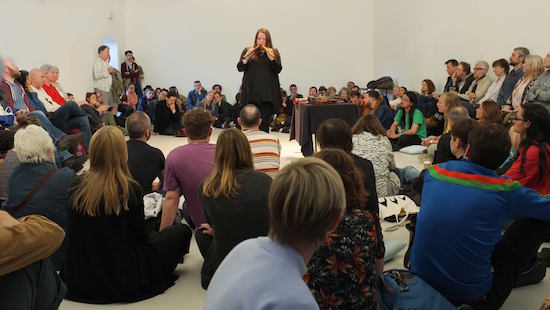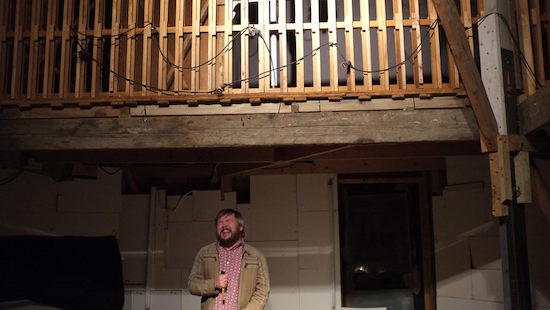Wysing sharpens up your senses
A trip to Wysing Arts centre, roughly ten miles outside Cambridge for their annual festival has for a number of years now been an essential aural refresher, a day of concentrated but lively listening, as well as a space for fanciful or focused thought around music. The festival previously went under the name Space-Time and previous themes have included 2014’s ‘The Future’ (an edition dedicated to female artists where the agenda wasn’t hammered home, it simply was) and 2015’s ‘The Multiverse’. This year’s change of name to Wysing Polyphonic introduced this year’s ‘zero amplification’ policy, leading one to prepare for microscopic attention to the grain and grist of sound.
And of course there was a good deal of this, from Laura Cannell’s gracefully pained folk meditations for fiddle and recorder (the ‘deconstructed bow’ wraps around the violin and the two recorders are played simultaneously, to stunning effect in both cases) to O Yama O’s dynamic play session with re-purposed objects on the floor of the Amphis stage. But the day turns out to be a multi-sensory treat. Keef Winter and Steve Ennis’s drum and metal-bashing duo is at times more visually than musically arresting, for example, but it’s also the things half-glimpsed that linger in the mind – passing through reception between two shows to see a seated group slowly passing a long, snaking band of paper between them, or Evan Parker soundchecking in a globule of mauve light. When I first arrive, I’m too late to get into the Amphis for what sounds like a performance on musical bowls so I just perch outside and let the vibrations place an eerie, unearthly filter over the billowing grass and almost clear-blue sky. The food on site is pretty good too.
Four shrutis are better than one
Since chancing on one in a rehearsal room a number of years ago, I’ve been smitten by the clean, almost synthetic tone of shruti boxes, Indian drone generators that are similar to (and derivative of) harmoniums but considerably less flexible in that you don’t have keys but only toggles that you slide to open or close the reed. Emptyset’s Paul Purgas has four in his collection and makes the most of their limitations, sometimes layering three at once through a combination of pedals and hands, using shorter, more rhythmic stabs to raise the intensity, or combining them with unfussy drumming or even white noise created by striking a bowl with a sheet of paper resting on it.

Humour and music can mix
Scepticism about the combination of big C Comedy and music is often justified. At the least convincing end, the whimsy of parts of the performance from Jenny Moore and her assortment of singers and drummers – which seemed to have been workshopped in the days leading up to the festival – could occasionally be cloying (one chap’s kind-of rap about his ‘Melancholy Wet Patch’ smacked of Cambridge Footlights), even though the communal buzz and the sense of ideas still fresh out of the lab won through. And generally there were many and varied forms of humour on offer at Wysing this year.
One example is during David Toop, Sylvia Hallett, Elaine Mitchener and Roger Turner’s improv/storytelling session, which features moments of almost alarming tension as each participant, seated around a large table in the centre of the Gallery, clatters, taps, rustles and saws at all manner of objects at their disposal (with Hallett also drawing on her considerable vocal range to produce clicks and grunts and beats from deep in her throat). Mitchener and Hallett both reminisce about attending weddings that weren’t their own, before Toop joins in with a story that I can’t catch all of (he speaks indistinctly and it at the far end of the table from me) but from which I get glimpses of scenes of harrowing poverty. But Toop also provides the occasion for the biggest release, as he asks to borrow a pair of ornate sewing scissors from Mitchener and starts cutting through pieces of tissue paper. Turner looks up to enquire, deadpan, if this is “a paper cutting solo”, and the other improvisers stop momentarily to concentrate on the faint sounds of snipping. On one level it’s just a muso joke, maybe, but it’s also humour that emerges from the performance and folds back into it. Openness to the feeling of the moment often goes hand in hand with an acute sense of the absurd.
But Wysing Polyphonic also demonstrates that the relative confines of the song-form can still provide plenty of scope for those who are both expert tragedians and brilliant comedians. Which brings us to that fact that…
Richard Dawson can command a room with nothing more than a hairbrush in his hand
A slightly unfortunate aspect of the Wysing programming this year is the necessity of choosing between Richard Dawson and Evan Parker. tQ plumps for the former partly because, of the Wysing’s two main gig spaces, the reclaimed wooden Amphis trumps the pristine white Gallery but also out of curiosity for what, say, ‘The Vile Stuff’ might sound like on acoustic guitar. It turns out Dawson hasn’t brought any instrument at all, claiming to have misunderstood the remit of the festival before seeing Parker arriving with a saxophone and realising his mistake.
I’m sure it’s been mentioned before that, as well as being one of this fractured country’s finest songwriters, Dawson is also one of its best stand-ups. So although Dawson the astonishing guitar stylist is sacrificed on this occasion, there is ample compensation. During his opening salvo, a “shepherd song” by Mike Waterson, he doesn’t even remove his rucksack, looking for all the world like he’s just passing through. Finally he drops it to the floor and dips in. “Let’s see what I’ve got in my bag… it would be absolutely awful if it was a human head.” An announcement that he recently “met someone” and was concerned for a while that happiness could affect his song writing leads to an anecdote about trying to keep a “pump” in while lying in bed. Somehow, this is all entirely charming.
Early on he also mentions he feels uncomfortable without a microphone. A friend with me offers a hairbrush as a prop, which is clutched in the customary manner – held just above waist-height, wrestled with like an unruly gearstick or a tiller in a gale. Later the brush is exchanged for a small percussion mallet.
We don’t get ‘The Vile Stuff’ anyway. But we don’t get a cappella favourite ‘Poor Old Horse’ either. Dawson ranges widely around his back catalogue and some personal favourites, and the pièce-de-résistance proves to be the fearful elegy ‘Joe The Quiltmaker’, delivered more forcefully than on The Glass Trunk but with the voice still cracking in the upper register, the narrative crackling with details that become more compellingly sinister as the song progresses. As chilly as the outcome, it still ends on a note of humanity, and with a sense of uneasy connectedness. Out of nothing, Richard Dawson has softened you up with self-effacing humour before taking you through the wringer once again.


